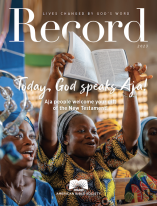Bible Reading Strategies for the Five Seasons
How to Get Your People into Scripture All Year Long
Churches have five seasons of the year:
September
Advent/Christmas
January
Lent/Easter
Summer
Yes, that’s a simplification, and it wanders from the liturgical calendar that governs many churches, but when it comes to planning new things for your congregation—new campaigns, emphases, programs, even preaching themes—these five seasons generally emerge with unique properties.
1. September is a time of new routines.
Kids are back in school. People are back from vacation. There are new shows on TV. And many churches use this as a time for new programs—small groups, Bible classes, perhaps a serious exegetical study from the pulpit. There is a scholastic feel to this season. In the weeks after Labor Day, people are trying out new routines. This is a great time to promote individual Bible-reading habits along with group discussion opportunities.
2. Advent/Christmas is often a time of frenzied family activity.
It’s a bad time to ask people to add something new to the schedule—unless it helps them do something they already want to do. And they might want to pull their families together in meaningful, spiritual moments. So family Bible activities are especially helpful. Note that this is also a time when unchurched people feel the most spiritual, so you might meet a felt need by distributing materials with the biblical Christmas story throughout your community.
3. January is a time of personal commitment.
It’s a lot like September, except the new energy is more inward. People make resolutions. They aim to improve themselves. Yes, there are often new schedules taking shape, but attention is also paid to personal discipline. For many, Bible-reading is a goal—and yet they might not know how or where to start. Your leadership is essential here. If they’re reading the Bible straight through, you’ll need to coach them through Leviticus. Or you might steer novices to key chapters and books of the Bible that will build an affinity for Scripture. It is a crucial habit-forming time, and you can help guide them.
4. Lent/Easter can be a time when people do important spiritual business with God.
There is great value in fasting and “giving things up for Lent” as part of this deepening relationship. You might also want to take this time to focus on some of the “wrestling” passages of Scripture—the lament Psalms, Job, Habakkuk, the Sermon on the Mount, Romans 7–8, many parables. These are not the easy answers of indoctrination but the challenges that lead to growth. And you might be surprised at the effect of these gritty passages on the semi-churched crowd that shows up only around Easter. It might be a side of Scripture they’re not familiar with.
5. Summer is a wild card.
Some churches nearly shut down, while others are bursting with new activity. Vacation Bible School is an anchor in many churches, but how can you build that out, giving families materials to use all summer long? Can you develop a series of fun-but-meaningful meditations to use at softball games and church picnics? Can you use the relaxed schedule of the summer to experiment with new models—a group that meets four nights in the same week and masters Philippians, or a group that aims to study James and live it out in specific ways each week? You might find that digital connection with your congregation is especially important in the summer. They might be vacationing several time zones away, but they can still get your verse-of-the-day in a text message.
As you lead people into Bible engagement, you may need to adopt different strategies in different seasons. We’re posting this in September, but you might be reading it in Advent. Wherever you find yourself on the calendar, consider the rhythms of life that your people are experiencing at that time, and plan your Bible ministry accordingly.
Thanks to the support of our faithful financial partners, American Bible Society has been engaging people with the life-changing message of God’s Word for more than 200 years.
Help us share God's Word where needed most.
Connect with our Bible engagement blog for leaders and receive a Bible-reading Habit Guide for your community.









